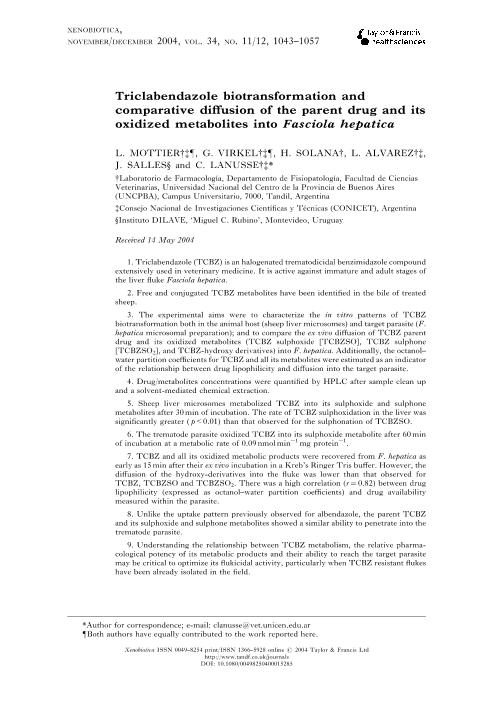Mostrar el registro sencillo del ítem
dc.contributor.author
Mottier, Maria de Lourdes

dc.contributor.author
Virkel, Guillermo Leon

dc.contributor.author
Solana, Hugo Daniel

dc.contributor.author
Alvarez, Luis Ignacio

dc.contributor.author
Sallés Abal, Juan Manuel

dc.contributor.author
Lanusse, Carlos Edmundo

dc.date.available
2020-08-13T15:48:26Z
dc.date.issued
2008-09
dc.identifier.citation
Mottier, Maria de Lourdes; Virkel, Guillermo Leon; Solana, Hugo Daniel; Alvarez, Luis Ignacio; Sallés Abal, Juan Manuel; et al.; Triclabendazole biotransformation and comparative diffusion of the parent drug and its oxidized metabolites into Fasciola hepatica; Taylor & Francis Ltd; Xenobiotica; 34; 11-12; 9-2008; 1043-1057
dc.identifier.issn
0049-8254
dc.identifier.uri
http://hdl.handle.net/11336/111643
dc.description.abstract
Triclabendazole (TCBZ) is an halogenated trematodicidal benzimidazole compound extensively used in veterinary medicine. It is active against immature and adult stages of the liver fluke Fasciola hepatica. Free and conjugated TCBZ metabolites have been identified in the bile of treated sheep. The experimental aims were to characterize the in vitro patterns of TCBZ biotransformation both in the animal host (sheep liver microsomes) and target parasite (F. hepatica microsomal preparation); and to compare the ex vivo diffusion of TCBZ parent drug and its oxidized metabolites (TCBZ sulphoxide [TCBZSO], TCBZ sulphone [TCBZSO2], and TCBZ-hydroxy derivatives) into F. hepatica. Additionally, the octanol-water partition coefficients for TCBZ and all its metabolites were estimated as an indicator of the relationship between drug lipophilicity and diffusion into the target parasite. Drug/metabolites concentrations were quantified by HPLC after sample clean up and a solvent-mediated chemical extraction. Sheep liver microsomes metabolized TCBZ into its sulphoxide and sulphone metabolites after 30min of incubation. The rate of TCBZ sulphoxidation in the liver was significantly greater (p<0.01) than that observed for the sulphonation of TCBZSO. The trematode parasite oxidized TCBZ into its sulphoxide metabolite after 60min of incubation at a metabolic rate of 0.09 nmol min-1 mg protein-1. TCBZ and all its oxidized metabolic products were recovered from F. hepatica as early as 15 min after their ex vivo incubation in a Kreb's Ringer Tris buffer. However, the diffusion of the hydroxy-derivatives into the fluke was lower than that observed for TCBZ, TCBZSO and TCBZSO2. There was a high correlation (r = 0.82) between drug lipophilicity (expressed as octanol-water partition coefficients) and drug availability measured within the parasite. Unlike the uptake pattern previously observed for albendazole, the parent TCBZ and its sulphoxide and sulphone metabolites showed a similar ability to penetrate into the trematode parasite. Understanding the relationship between TCBZ metabolism, the relative pharmacological potency of its metabolic products and their ability to reach the target parasite may be critical to optimize its flukicidal activity, particularly when TCBZ resistant flukes have been already isolated in the field.
dc.format
application/pdf
dc.language.iso
eng
dc.publisher
Taylor & Francis Ltd

dc.rights
info:eu-repo/semantics/openAccess
dc.rights.uri
https://creativecommons.org/licenses/by-nc-sa/2.5/ar/
dc.subject
triclabendazole
dc.subject
biotransformation
dc.subject
parasite uptake
dc.subject
Fasciola hepatica
dc.subject.classification
Otras Ciencias Veterinarias

dc.subject.classification
Ciencias Veterinarias

dc.subject.classification
CIENCIAS AGRÍCOLAS

dc.title
Triclabendazole biotransformation and comparative diffusion of the parent drug and its oxidized metabolites into Fasciola hepatica
dc.type
info:eu-repo/semantics/article
dc.type
info:ar-repo/semantics/artículo
dc.type
info:eu-repo/semantics/publishedVersion
dc.date.updated
2020-05-19T17:25:07Z
dc.journal.volume
34
dc.journal.number
11-12
dc.journal.pagination
1043-1057
dc.journal.pais
Reino Unido

dc.journal.ciudad
Londres
dc.description.fil
Fil: Mottier, Maria de Lourdes. Universidad Nacional del Centro de la Provincia de Buenos Aires. Facultad de Ciencias Veterinarias. Departamento de Fisiopatología. Laboratorio de Farmacología; Argentina. Consejo Nacional de Investigaciones Científicas y Técnicas. Centro Científico Tecnológico Conicet - Tandil; Argentina
dc.description.fil
Fil: Virkel, Guillermo Leon. Universidad Nacional del Centro de la Provincia de Buenos Aires. Facultad de Ciencias Veterinarias. Departamento de Fisiopatología. Laboratorio de Farmacología; Argentina. Consejo Nacional de Investigaciones Científicas y Técnicas. Centro Científico Tecnológico Conicet - Tandil; Argentina
dc.description.fil
Fil: Solana, Hugo Daniel. Universidad Nacional del Centro de la Provincia de Buenos Aires. Facultad de Ciencias Veterinarias. Departamento de Fisiopatología. Laboratorio de Farmacología; Argentina
dc.description.fil
Fil: Alvarez, Luis Ignacio. Consejo Nacional de Investigaciones Científicas y Técnicas. Centro Científico Tecnológico Conicet - Tandil; Argentina. Universidad Nacional del Centro de la Provincia de Buenos Aires. Facultad de Ciencias Veterinarias. Departamento de Fisiopatología. Laboratorio de Farmacología; Argentina
dc.description.fil
Fil: Sallés Abal, Juan Manuel. Dirección General de Laboratorios Veterinarios Miguel Rubino; Argentina. Consejo Nacional de Investigaciones Científicas y Técnicas. Centro Científico Tecnológico Conicet - Tandil; Argentina
dc.description.fil
Fil: Lanusse, Carlos Edmundo. Consejo Nacional de Investigaciones Científicas y Técnicas. Centro Científico Tecnológico Conicet - Tandil; Argentina. Universidad Nacional del Centro de la Provincia de Buenos Aires. Facultad de Ciencias Veterinarias. Departamento de Fisiopatología. Laboratorio de Farmacología; Argentina
dc.journal.title
Xenobiotica

dc.relation.alternativeid
info:eu-repo/semantics/altIdentifier/url/https://www.tandfonline.com/doi/abs/10.1080/00498250400015285
dc.relation.alternativeid
info:eu-repo/semantics/altIdentifier/doi/http://dx.doi.org/10.1080/00498250400015285
Archivos asociados
